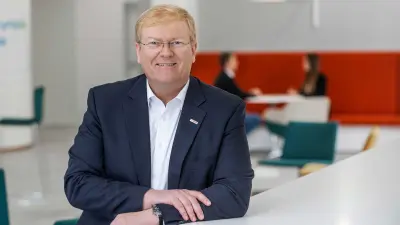The climate-neutral city — sustainable lifestyle and business activity

2023-06-21
The more significant the role played by cities in climate change, the greater the effect we can achieve by applying a combination of intelligent and sustainable solutions in the urban environment.
by Stefan Hartung
We cannot halt global urbanization. But we should use it to our advantage and apply leverage in cities more than anywhere else. Even more than before, our efforts to mitigate global warming should focus on the city. This is not simply because the key to a climate-neutral world is to be found in metropolitan areas. But also because urban populations are particularly exposed to the hazards of climate change. In Berlin, for example, the number of extremely hot days has almost tripled over the past 70 years, to an annual average of 15.7 days.
800 million
city dwellers estimated to be at risk from rising sea levels by 2050
And the prospects for some of the world’s other conurbations are even more dramatic. The C40 global youth and mayors forum estimates that some 800 million city-dwellers will be threatened by rising sea levels by 2050. On top of this, there are extreme weather conditions. It can be expected that torrential rain and drought will jeopardize cities’ supplies of food and water more frequently than at present.
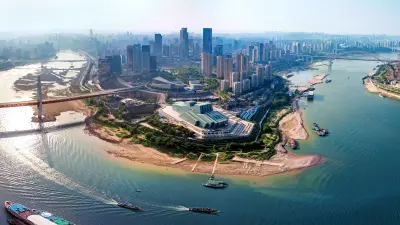
Cities — the innovative drivers of human history
In other words, it is above all in the city that the battle against climate change will be decided, and not just in the rural environment. But I firmly believe that this insight should give us courage. Cities have always been much more than just densely built-up areas. Cities are the innovative drivers of the history of modern humankind, and the incubators and accelerators of our society. They are the magnifiers of the challenges of our age — and provide stimuli for the future.
The intellectual power of these centers is something we need more than ever. For the first time, the world’s cities are faced with a common — and tremendous — task. They have to find answers to climate change, yet at the same time protect their inhabitants’ prosperity. Indeed, many cities first of all have to secure the foundations for that prosperity. There are no patent solutions. The geographical and economic differences between the world’s cities are far too big for that to be the case. However, I’m sure that success can above all be achieved if people focus on the things that have always characterized prosperous cities: things such as creativity, open-mindedness, and entrepreneurial spirit. The courage to embrace technology is another such virtue.
Visionary solutions are required
After all, complex problems require solutions that are multilayered, and frequently also visionary. When the first urban planners had the idea of making London’s trains run underground, people considered them insane. The Times commented that nobody would swap a ride in a horse-drawn omnibus for a dark journey through the fetid underworld. And the elderly prime minister Lord Palmerston stayed away from the opening of the first underground line, declaring that, at his age, he was glad of all the days he could still spend above ground. What is interesting about this example, though, is that a technology that fundamentally already existed — the railroad — was completely reinvented. And this reinvention happened nearly 30 years before the actual new technology — the motor car — appeared on England’s roads for the first time.
So, while progress is truly revolutionary on the one hand, on the other it consists of astute adjustments to new circumstances. The same applies to our path into a climate-neutral future — a path for which there are fortunately several solutions available. The spectrum stretches from battery-electric powertrains, to green hydrogen and heat pumps, to fuel cells and renewable synthetic fuels. For some of these solutions, investment in infrastructure is still needed, while others still need to go through a further development stage or stages. But given the climate situation, it would be reckless to dismiss them prematurely.
Nor does it make much sense to waste our time playing one technology off against another. Instead, we should look for the best way of combining these different approaches with each other.
Less consumption thanks to smart home

In Germany, we consume more energy in our homes than on our roads. The transport sector accounts for 28 percent of total consumption. The figure for heating, hot water, and lighting is 30 percent. Through intelligent controls alone, we can already make considerable savings here: anyone who systematically turns their home into a smart home can save up to 36 percent heating energy.
But of course, if a city is to become climate neutral, it is crucial that it converts to alternative fuels. According to government plans, any new heating systems installed after 2024 must run at least 65 percent on renewables. That is a step in the right direction. But for the move to alternative heating to be affordable, several technological solutions need to be given a chance.
36%
less heating energy is possible when turning your home into a smart home
Investment of 300 million euros in heat pumps
A heat pump run on green electricity is an ideal way of heating sustainably. That is why, at Bosch, we will be investing another 300 million euros in this area in the years to come. But right now, two-thirds of all buildings in Germany are still not equipped to rely solely on heat pumps. And not everyone can afford the high costs associated with conversion. In cases such as these, therefore, we also have to consider hybrid solutions in which a heat pump does 80 percent of the heating work, leaving the gas-fired boiler to cushion peak loads. This is a sustainable solution for truly cold winters.
When we speak about our climate-neutral future, we generally focus on new heating systems and new cars. But what are we going to do with the millions of gas-fired boilers already sold, or with the legacy vehicles already driving on our roads? Even the idea of a policy prohibiting them seems absurd — it would neither be socially acceptable, nor would it make economic or ecological sense.
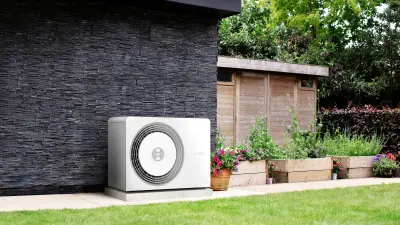
New generation of boilers — powered by 100% green hydrogen
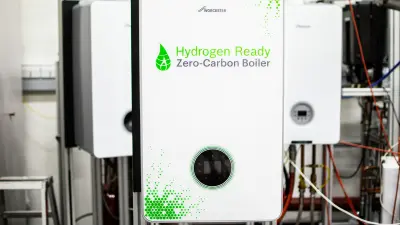
Fortunately, technology offers us a way out here as well. Currently, half of all German homes heat with gas. Even now, most of these boilers could also use hydrogen. In some cases, they could run on a mix containing up to 20 percent hydrogen. What’s more, this could be done without much effort, using the existing gas grid. Much more will be possible in the future. At our plant in Worcester, England, we are currently developing a new generation of boilers that can be run 100 percent on green hydrogen.
The example of an admixture of hydrogen shows the direction a successful sustainability strategy should take, creating new solutions while also optimizing existing ones. The technological foundations of our society and industry cannot be replaced overnight — and certainly not in isolation. We have to make today’s infrastructure and technology fit for the near future, while at the same time working all-out on completely new solutions for the more distant future. Bold visions — combined with the level-headed application of the levers already at our disposal.
Massive expansion of renewable energies
If we look at mobility, we can see how decisive such a two-pronged approach can be. In the future, we will have powertrains running on batteries, fuel cells, and hydrogen that can be operated in a climate-neutral way. But what will we do in the interim? What will we do with the roughly 1.4 billion vehicles driving on the world’s roads today and, moreover, tomorrow? The answer is that we should fill them up with synthetic fuels. That is possible without having to retrofit current engines. Moreover, it presents no problems for the filling stations we already have.
But this move will not be possible without a huge expansion of renewables. Synthetic fuels are only climate neutral if we use wind power, photovoltaics, or other sources of renewable energy and CO₂ from the ambient air to produce them. This applies in essence to hydrogen as well and, as is well known, also to battery-electric powertrains. To achieve our climate targets, we need more digitalization, more dynamism, more “German speed” — to quote German Chancellor Olaf Scholz. By that, I don’t just mean faster approval procedures — but also a general open-mindedness toward technology. It would be a big step forward if, in certain areas, we were to discuss the opportunities as intensively as our misgivings. To put it another way, if we want to move forward at “German speed”, we also need “German flexibility.”
Components for electrolyzers
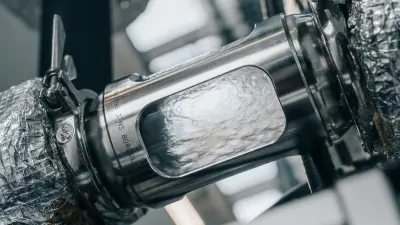
In this context, there is no question that businesses have to assume responsibility, and not just policymakers and society. Over the next three years, Bosch will invest some 3 billion euros in technology that mitigates global warming. A major part of this will go into the development of components for electrolyzers. These are systems that use electrolysis to break water into hydrogen and oxygen — using green electricity and thus without emitting any CO₂. The big advantage is that hydrogen can store electricity produced by nature. In other words, power supplies are secure even when there is no wind or sunshine.
Energy supply of entire city quarters with the stationary fuel cell
Particularly for cities, stationary fuel cells offer an especially efficient method of converting this hydrogen back into heat and power. Such a fuel cell is not much larger than a refrigerator, and any number of further units can be added to provide a source of power for residential buildings and hospitals, and even for entire urban districts. If we run these fuel cells on green hydrogen, no carbon emissions will be created. And there is a further similarity between fuel cells on the one hand and hydrogen-ready gas-fired boilers and renewable synthetic fuels on the other: we can make use of the infrastructure that already exists, while building up the new infrastructure. This is because a fuel cell can also be run on conventional natural gas — and even when it is, it emits two-thirds less than coal-fired power stations.
In fuel cells as well, Bosch is making considerable upfront investments, with a total of half a billion euros going into developing this technology. After all, the fuel cell has an important role to play in sector coupling — in creating an integrated view of our energy system, in other words. This is because a fuel cell is capable not only of lighting homes and heating hospitals, but also of recharging the batteries of electric cars and eBikes. In the future, therefore, heat, power, and mobility will be closely interwoven — and nowhere more closely than in the city.

500 million Euros
Bosch is investing in the development of fuel cell technology
Cities prosper if politics, business, culture and technology interact as closely as possible
I’ve now written a lot about technology. But even tech enthusiasts and engineers know that a city is more than just efficiency and digital processes. Or, to put it another way: the energy of a metropolis isn’t just measured in megawatts. But what is it that distinguishes a dynamic center full of positive energy from a settlement that is merely overseen and administered? I believe that cities prosper and flourish if politics and business, culture and technology interact as closely and unreservedly as possible. It was not political goals that held Rome together, but also infrastructure and law. Renaissance Florence not only bequeathed us pioneering art and a completely new picture of humanity, but also revolutionized building techniques and left its mark on modern banking.
Successful cities have always looked beyond their city gates. This is still the case today — and applies to climate action as well. Over-zealous, isolated solutions only serve to push the problems to one side. But anyone who isolates themselves through prohibitions will do little for the climate and put the lively atmosphere of a city at risk. Moreover, they will ignore the responsibility a city has toward its surrounding area.
The common goal of mitigating global warming calls for public spirit in the classic sense of the word — in the sense of commitment and the realization that other interest groups have to be part of the solution. In other words, for climate action we need bold policies, an efficient and values-centered economy, a culture that is open to the future, and a highly developed range of affordable technologies.
The threat posed by climate change is so great that we should not exclude any solution a priori. Every gram of CO₂ saved counts — also here in Germany. The country has made a commitment to be climate neutral by 2045. This target for sure is only achievable, if we tear down taboos, just as cities have torn down their walls.

